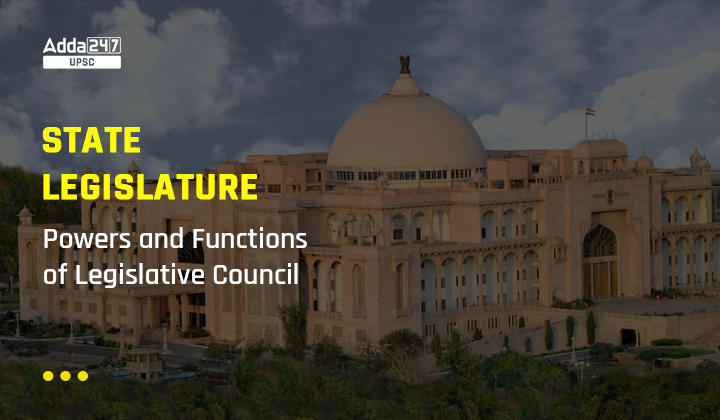Table of Contents
What is State Legislature?
The State Legislature is the law-making body of a state in India. It is made up of two houses: the Legislative Assembly (Vidhan Sabha) and the Legislative Council (Vidhan Parishad). The Legislative Assembly is the lower house, and the Legislative Council is the upper house. The Legislative Assembly is directly elected by the people of the state. The number of seats in the Legislative Assembly varies from state to state, depending on the population of the state. The Legislative Council is indirectly elected by the members of the Legislative Assembly, local government bodies, and other educational and professional institutions.
Part VI, Chapter III of the Constitution focuses on the State Legislature, encompassing both legislative and executive aspects. This is a crucial topic in political studies, particularly for the IAS Exam. Articles 168 to 212 in this part detail the state legislature’s structure, makeup, timeframe, officials, processes, privileges, and authorities
The State Legislature has the power to make laws on all matters that are not specifically mentioned in the Union List or the Concurrent List of the Constitution of India. The Union List contains matters that are exclusively under the jurisdiction of the Union Government, while the Concurrent List contains matters that are under the jurisdiction of both the Union Government and the State Governments.
The State Legislature also has the power to control the finances of the state. It can approve the budget of the state government and it can also levy taxes. The State Legislature also has the power to create and abolish offices in the state government. The State Legislature is an important part of the federal system of government in India. It is responsible for making laws that are specific to the state and it also has the power to control the finances of the state. The State Legislature is also responsible for electing the President of India.
Bicameral and Unicameral States
There are two main types of legislatures: bicameral and unicameral.
- Bicameral legislatures: A bicameral legislature denotes a state possessing two distinct chambers for lawmaking, responsible for actions like budget approval and law enactment. While India’s national level maintains a bicameral structure, states can establish their own. Only six Indian states—Andhra Pradesh, Bihar, Karnataka, Maharashtra, Telangana, and Uttar Pradesh—operate with a bicameral legislature. Nevertheless, it’s worth noting that a bicameral system might not be as efficient as a unicameral one.
- Unicameral legislatures: In a unicameral legislature, a single legislative chamber handles all responsibilities, including enacting laws, approving budgets, and discussing global and local matters. Due to its widespread use, a unicameral legislature is the prevailing model. This practical legislative structure enhances lawmaking accessibility and minimizes potential hurdles. The populace directly elects members of the unicameral legislative body (Legislative Assembly).
Functions of State Legislature – Legislative Assembly
The State’s true power hub is the popularly elected Legislative Assembly. Its size should ideally remain between 60 and 500 members. However, certain states like Sikkim, Arunachal Pradesh, Goa, etc., can have smaller assemblies. Constituencies should ideally balance population and seats for uniformity across the State. Additionally, specific rules apply to SC, ST, and Anglo-Indian representation. If needed, the Governor can nominate an Anglo-Indian member for fair representation.
Functions of the State Legislature – Legislative Council
The State’s Legislative Council consists of a maximum of one-third of the total members in the State’s Legislative Assembly, with a minimum of 40 members. Nevertheless, Jammu and Kashmir has a smaller strength of 36 members. The specific composition of the Council, as outlined in the Constitution, is subject to potential changes, with the ultimate authority resting with the Union Parliament. Until the Union Parliament enacts legislation on this matter, the composition will follow the guidelines detailed in the Constitution, which are explained below:
Duration of Legislative Assembly & Legislative Council
The composition involves a mix of nomination and indirect election, following proportional representation via single transferable vote. Members are sourced diversely, creating a varied Council. Roughly, 5/6 members are indirectly elected and 1/6 nominated. The Legislative Assembly’s term is five years, subject to early dissolution by the Governor. During an emergency, Parliament can extend it by up to one year at a time, not exceeding six months after the emergency ends (Article 172(1)). In contrast, the Legislative Council isn’t dissolved like the Assembly. It’s a permanent body unless both the Legislative Assembly and Parliament abolish it through proper procedures. Yet, no member is permanent as one-third retire every two years, amounting to a six-year term. Re-election after a term is possible.
(a) One-third of the Council members are elected by local body members like municipalities and district boards.
(b) One-twelfth are elected by graduates with a three-year standing in the state.
(c) Another one-twelfth are elected by teachers with 3 years’ experience in state educational institutes above secondary level.
(d) A third is elected by Legislative Assembly members who aren’t Assembly members themselves.
(e) The remaining are Governor-nominated individuals with expertise in science, literature, cooperatives, art, and social service. (The courts can’t question Governor’s nominations’ propriety or good faith.)
Power of State Legislature
It possesses authority to formulate laws and govern the nation. As per Article 168 of the Indian Constitution, a state has the option of either a unicameral structure (involving the Legislative Assembly) or a bicameral arrangement (comprising the Legislative Council and Legislative Assembly).

| Relatable Articles | |
| Emergency in India | Centre State Relations |
| Special Provisions Act | Cooperative Societies |


 UPSC Prelims Exam Date 2024, Check New E...
UPSC Prelims Exam Date 2024, Check New E...
 UPSC Eligibility Criteria 2024- Age Limi...
UPSC Eligibility Criteria 2024- Age Limi...
 UKPSC RO ARO Result 2024 Out, Download M...
UKPSC RO ARO Result 2024 Out, Download M...







